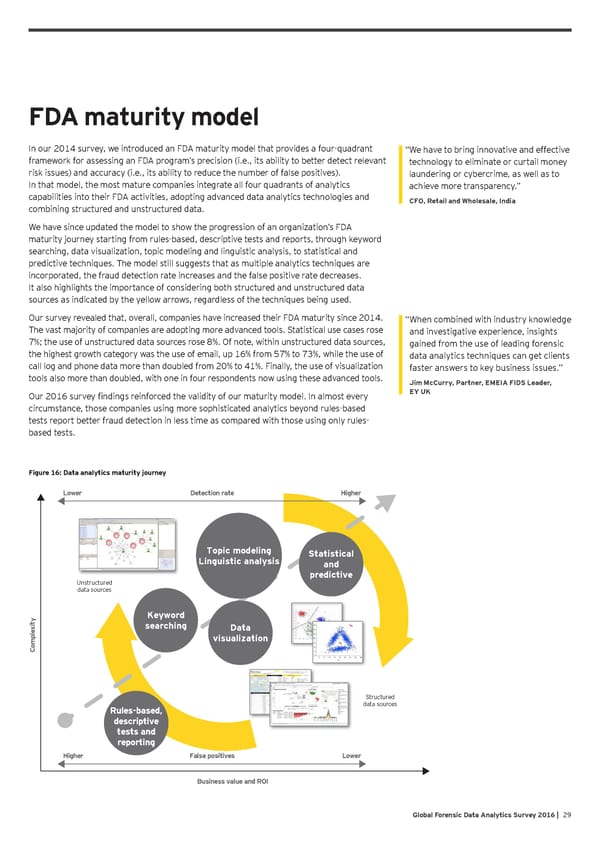FDA maturity model In our 2014 survey, we introduced an FDA maturity model that provides a four-quadrant “ We have to bring innovative and effective framework for assessing an FDA program’s precision (i.e., its ability to better detect relevant technology to eliminate or curtail money risk issues) and accuracy (i.e., its ability to reduce the number of false positives). laundering or cybercrime, as well as to In that model, the most mature companies integrate all four quadrants of analytics achieve more transparency.” capabilities into their FDA activities, adopting advanced data analytics technologies and CFO, Retail and Wholesale, India combining structured and unstructured data. We have since updated the model to show the progression of an organization’s FDA maturity journey starting from rules-based, descriptive tests and reports, through keyword searching, data visualization, topic modeling and linguistic analysis, to statistical and predictive techniques. The model still suggests that as multiple analytics techniques are incorporated, the fraud detection rate increases and the false positive rate decreases. It also highlights the importance of considering both structured and unstructured data sources as indicated by the yellow arrows, regardless of the techniques being used. Our survey revealed that, overall, companies have increased their FDA maturity since 2014. “ When combined with industry knowledge The vast majority of companies are adopting more advanced tools. Statistical use cases rose and investigative experience, insights 7%; the use of unstructured data sources rose 8%. Of note, within unstructured data sources, gained from the use of leading forensic the highest growth category was the use of email, up 16% from 57% to 73%, while the use of data analytics techniques can get clients call log and phone data more than doubled from 20% to 41%. Finally, the use of visualization faster answers to key business issues.” tools also more than doubled, with one in four respondents now using these advanced tools. Jim McCurry, Partner, EMEIA FIDS Leader, Our 2016 survey findings reinforced the validity of our maturity model. In almost every EY UK circumstance, those companies using more sophisticated analytics beyond rules-based tests report better fraud detection in less time as compared with those using only rules- based tests. Figure 16: Data analytics maturity journey Lower Detection rate Higher Structured Topic modeling Statistical data sources Linguistic analysis and predictive Unstructured data sources Keyword searching Data visualization ComplexityUnstructured data sources Structured Rules-based, data sources descriptive tests and reporting Higher False positives Lower Business value and ROI Global Forensic Data Analytics Survey 2016 | 29
 Shifting into High Gear: Mitigating Risks and Demonstrating Returns Page 28 Page 30
Shifting into High Gear: Mitigating Risks and Demonstrating Returns Page 28 Page 30